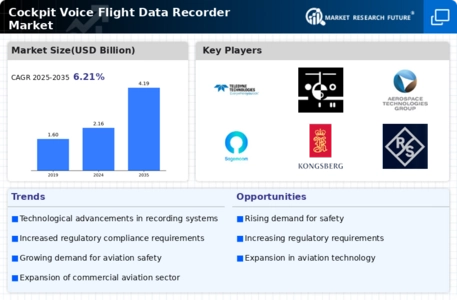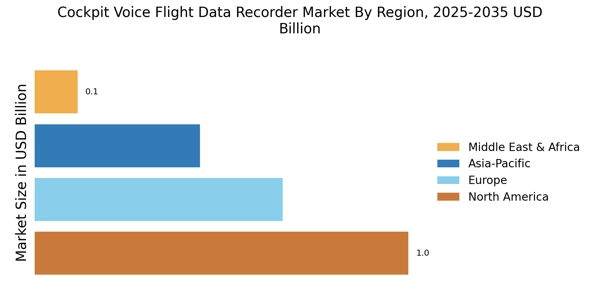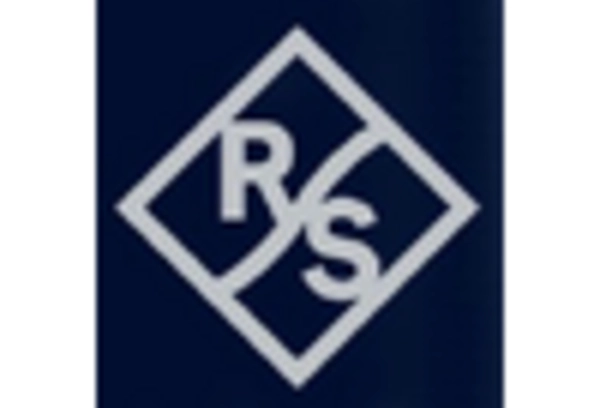Focus on Safety
The increasing focus on safety within the aviation sector is a primary driver for the Cockpit Voice Flight Data Recorder Market. Airlines and regulatory bodies are prioritizing the collection and analysis of flight data to prevent accidents and improve operational efficiency. The emphasis on safety is reflected in the rising number of safety audits and the implementation of advanced data analytics tools. As of 2025, the market is expected to witness a notable increase in demand for cockpit voice recorders, as they are essential for post-incident investigations. This heightened focus on safety not only enhances passenger confidence but also encourages airlines to invest in state-of-the-art recording technologies. Consequently, the Cockpit Voice Flight Data Recorder Market is likely to expand as stakeholders recognize the value of comprehensive data collection in ensuring safer air travel.
Regulatory Compliance
Regulatory compliance plays a crucial role in shaping the Cockpit Voice Flight Data Recorder Market. Governments and aviation authorities worldwide are enforcing stringent regulations regarding flight data recording to enhance safety and accountability. For example, the International Civil Aviation Organization (ICAO) mandates that all commercial aircraft be equipped with flight data recorders that meet specific standards. This regulatory pressure is likely to drive the market as airlines invest in upgrading their systems to comply with these requirements. As of 2025, it is estimated that compliance-related investments could account for a significant portion of the market's growth, potentially reaching a valuation of several billion dollars. The ongoing evolution of regulations suggests that manufacturers must remain agile and innovative to meet the changing demands of the Cockpit Voice Flight Data Recorder Market.
Technological Advancements
The Cockpit Voice Flight Data Recorder Market is experiencing a surge in demand due to rapid technological advancements. Innovations in data storage, processing capabilities, and miniaturization of components are enhancing the functionality of flight data recorders. For instance, the integration of cloud technology allows for real-time data transmission, which is becoming increasingly vital for airlines and regulatory bodies. As of 2025, the market is projected to grow at a compound annual growth rate of approximately 5.2%, driven by these advancements. Furthermore, the introduction of artificial intelligence in data analysis is expected to improve incident investigation processes, thereby increasing the overall safety of air travel. This trend indicates a shift towards more sophisticated systems that not only record but also analyze flight data, making the Cockpit Voice Flight Data Recorder Market more dynamic.
Integration of Advanced Features
The integration of advanced features into cockpit voice recorders is a notable driver for the Cockpit Voice Flight Data Recorder Market. Modern recorders are increasingly equipped with functionalities such as voice recognition, data encryption, and enhanced playback capabilities. These features not only improve the usability of the devices but also enhance the security of sensitive flight data. As airlines seek to leverage technology for operational efficiency, the demand for recorders with advanced capabilities is likely to increase. By 2025, the market may see a shift towards multifunctional devices that serve various purposes beyond mere recording. This evolution suggests that manufacturers must innovate continuously to stay competitive in the Cockpit Voice Flight Data Recorder Market, catering to the evolving needs of airlines and regulatory bodies.
Market Expansion in Emerging Economies
The Cockpit Voice Flight Data Recorder Market is poised for expansion in emerging economies, where air travel is witnessing unprecedented growth. Countries in Asia-Pacific and Latin America are experiencing a surge in air traffic, leading to increased investments in aviation infrastructure. As airlines in these regions expand their fleets, the demand for cockpit voice recorders is expected to rise correspondingly. By 2025, it is projected that emerging markets could account for a substantial share of the overall market, driven by the need for compliance with international safety standards. This trend indicates a shift in the market landscape, as manufacturers may need to tailor their products to meet the specific needs of these regions. The growth potential in emerging economies presents a significant opportunity for stakeholders in the Cockpit Voice Flight Data Recorder Market.


















Leave a Comment